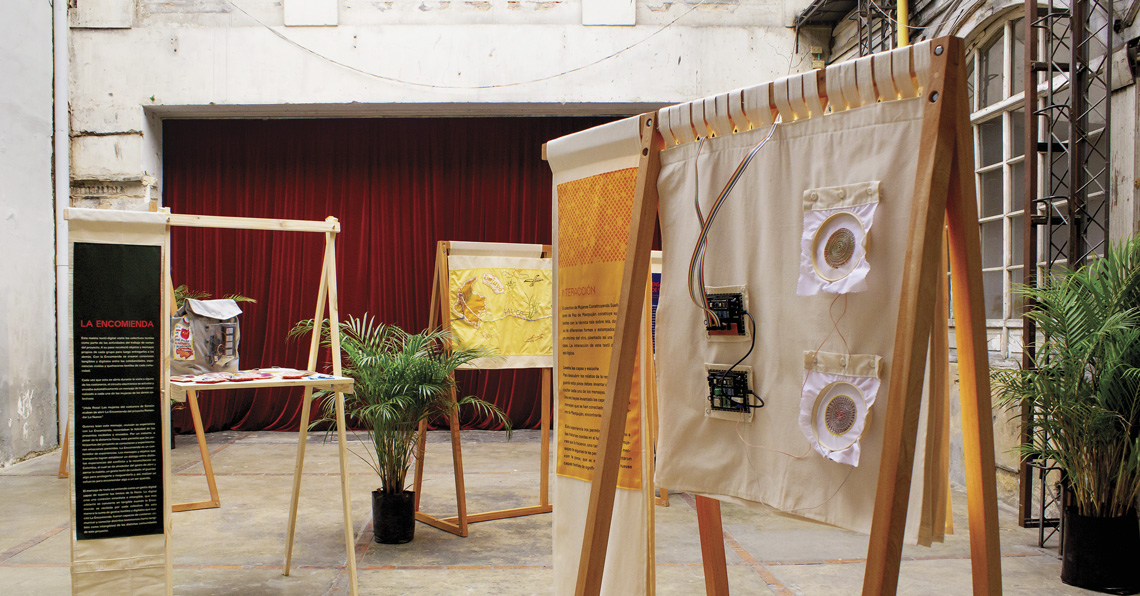Remendar lo nuevo (mending the new)
Issue: XXVIII.5 September - October 2021Page: 6
Digital Citation
Authors:
Tania Pérez-Bustos
In Colombia, textile-making has emerged as an important way for collectives of women to process the grief and trauma that they have suffered through many years of conflict. Since the 2016 peace agreement, the country has turned toward processes of reconciliation. The project Remendar lo Nuevo (Mending the New) brought together researchers from the Universidad Nacional de Colombia, Universidad de Antioquia, and Universidad de Los Andes with women's textile collectives in Chocó, Bolivar, and Antioquia to explore how physical and digital artifacts can be combined to create an archive of textile testimonials. The project was called Remendar lo Nuevo (Mending the New) because communities were being asked to explore what reconciliation means for them. In many cases they are still figuring out how (and with whom) to mend relationships in an unstable situation where violence still regularly flares.
As they traveled from one textile collective to another, these digital-textile artifacts created bonds between the collectives.
During the two-year project, researchers organized a series of workshops with communities, inviting them to think through their textile-making about reconciliation. They also organized a couple of mingas (spaces for collaboration and thinking/making together) where researchers, artists, designers, and technologists worked with women's stories and pieces to add digital artifacts into their processes of memorial-making. As part of the project, various digital-textile artifacts were created. Some of them had the capacity to send SMS messages or to store recorded oral histories. As they traveled from one textile collective to another, these digital-textile artifacts created bonds between the collectives and between the collectives and the research group. The emphasis was not on creating the artifacts themselves but rather on creating spaces for shared reflection in and through the workshops and the mingas. The physical and sensory qualities of textile work create "textile atmospheres" that shift how people interact. These atmospheres are profoundly reflective spaces where, through material handwork and in a supportive group, women can re-narrate the traumas that they have experienced. The project recognized these spaces (and practices) as improvisational technologies of healing.
 |
Partial view of The Time(s) to Listen. |
 |
The Time(s) to Listen exhibit detail showing a proposed interaction in the textile cloth made by group Artesanías Guayacán. |
 |
Telón Choibá Atrateño being measured by Yaneth Mosquera. |
 |
Cartografía de Mampuján shown by Janiris Pulido. Testimonial textile piece made by group Tejedoras de Sueños y Sabores de Paz of Mampuján. |
Over the course of the project (2018–2020), researchers captured the spirit of collectivity in an online exhibition, an e-book, and an online archive. These were collaboratively shaped with project participants. The online exhibition Los Tiempos de la Escucha (The Time(s) to Listen) includes images of the textile works and oral testimonies recorded by the women. It reveals some of the metaphors that the communities use to characterize reconciliation: as cooking, as a medicinal plant, in the movement of animals. The e-book Remendar lo Nuevo: Compartiendo Aprendizajes (Mending the New: Sharing Learnings) was largely composed by the communities themselves, and includes pieces of oral storytelling, photographs, and texts. Finally, the Archivo Digital de Textiles Testimoniales (Digital Archive of Textile Testimonies) is a wider digital archive that links the work of 10 different initiatives of sewing for memory in Colombia.
 |
Group Artesanías Guayacán from Bojayá, Chocó. |
 |
Group Tejedoras por la Memoria de Sonsón exploring one of the digital textile prototypes, La Encomienda, made during the community workshops. |
 |
Group Tejedoras por la Memoria de Sonsón, Antioquia. |
 |
Group Mujeres Tejiendo Sueños y Sabores de Paz of Mampuján, Bolívar. |
 |
Group Artesanías Choibá from Quibdó, Chocó. |
Each of these resources amplifies the women's own documentation and memorialization practices to new publics inside and outside of academia, inviting outsiders into each community to connect to the stories of rupture and repair that are being made and remade through textiles and electronic components.
The project was funded by the Ministry of Science in Colombia in collaboration with the Newton Fund in the U.K.
Tania Pérez-Bustos is an associate professor in the School of Gender Studies at Universidad Nacional de Colombia. She works on knowledge dialogues and knowledge-making practices that interrelate technoscientific knowledge with popular knowledge. Her current research examines handmade-textile processes as technologies of knowing and caring. [email protected]
Copyright held by author
The Digital Library is published by the Association for Computing Machinery. Copyright © 2021 ACM, Inc.


